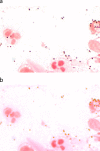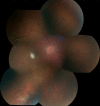Bacterial and Fungal Endophthalmitis
- PMID: 28356323
- PMCID: PMC5475221
- DOI: 10.1128/CMR.00113-16
Bacterial and Fungal Endophthalmitis
Abstract
Endophthalmitis is a severe eye infection that may result in permanent loss of useful vision in the affected eye. Most cases are exogenous and occur as a complication of cataract surgery, an intravitreal injection, or penetrating ocular trauma. Endogenous endophthalmitis results from hematogenous seeding of the eye by bacteria or fungi, but bacteremia or fungemia may be transient and patients may present without symptoms of systemic infection. Nearly all endophthalmitis patients present with decreased vision, and some also have eye pain. Eye examination usually reveals a hypopyon and intraocular inflammation. Diagnosis is clinical, supported by cultures of the vitreous and/or aqueous or by blood cultures in some endogenous cases. Molecular diagnostic techniques have been used in research laboratories for pathogen identification in endophthalmitis and offer the possibility of rapid diagnosis, including in culture-negative cases. Intravitreal injection of antibiotics is the most important component of treatment; some cases also benefit from surgical debridement of the vitreous by a vitrectomy. The visual outcome depends partly on the pathogen: coagulase-negative staphylococcal endophthalmitis has a better prognosis than does streptococcal endophthalmitis, for example. Endophthalmitis is a medical emergency, and prompt diagnosis and treatment are essential for saving vision.
Keywords: Candida endophthalmitis; bacterial endophthalmitis; bleb-related endophthalmitis; endophthalmitis; endophthalmitis prophylaxis; fungal endophthalmitis; keratitis-related endophthalmitis; postoperative endophthalmitis; posttraumatic endophthalmitis.
Copyright © 2017 American Society for Microbiology.
Figures







References
-
- Falavarjani KG, Nekoozadeh S, Modarres M, Parvaresh MM, Hashemi M, Soodi R, Alemzadeh SA. 2012. Isolates and antibiotic resistance of culture-proven endophthalmitis cases presented to a referral center in Tehran. Middle East Afr J Ophthalmol 19:361–363. doi:10.4103/0974-9233.102740. - DOI - PMC - PubMed
Publication types
MeSH terms
Substances
LinkOut - more resources
Full Text Sources
Other Literature Sources
Medical
Molecular Biology Databases

